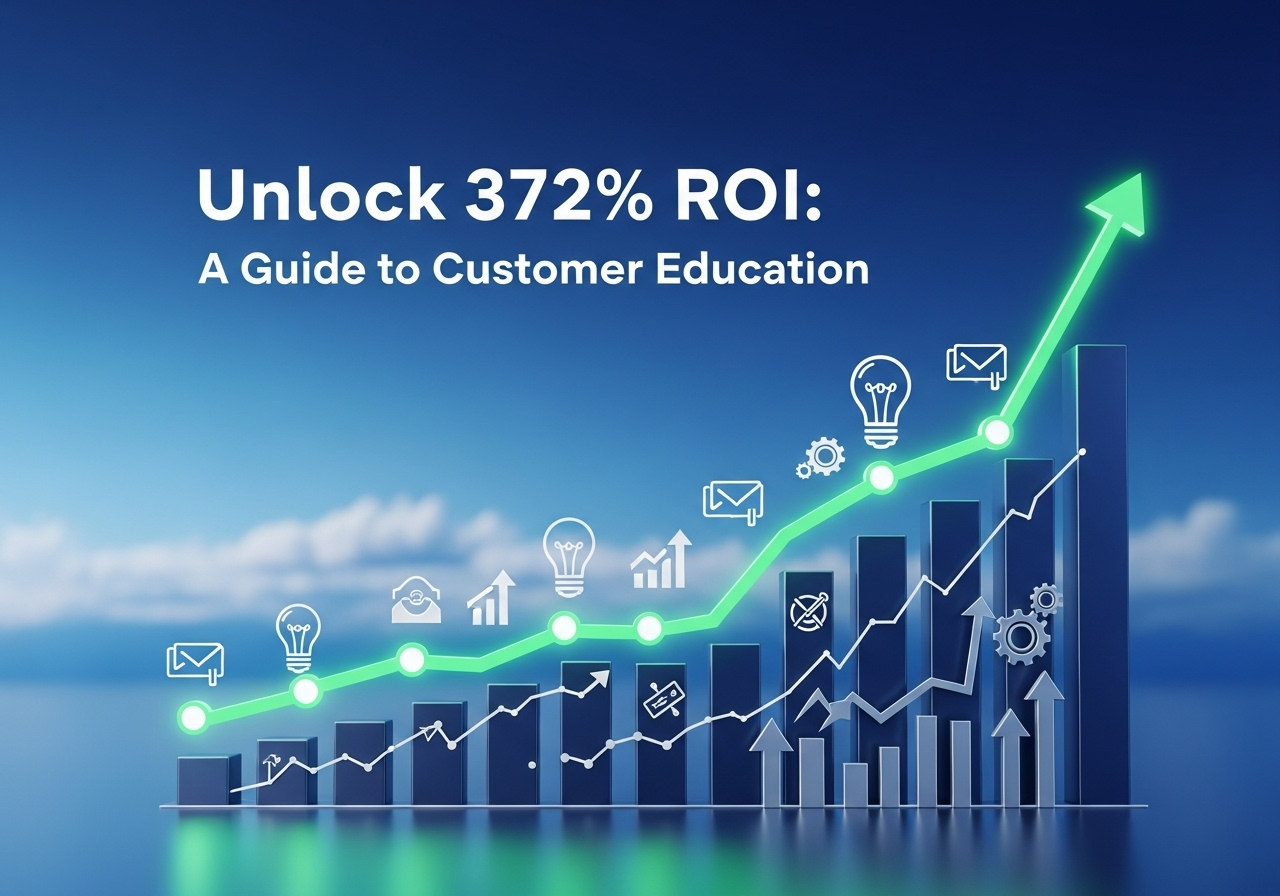Unlock 372% ROI: A Guide to Customer Education
In today’s hyper-competitive business landscape, here’s a statistic that should make every executive take notice: customer education initiatives can deliver an astonishing 372% ROI over just three years, with many companies recouping their entire investment in as little as seven months. As we navigate through 2025, customer education has evolved from a nice-to-have support function to a critical revenue driver that directly impacts your bottom line.
The Business Case for Customer Education in 2025
The numbers don’t lie – customer education has become a cornerstone of successful business strategies. Recent data reveals that 96% of organizations have fully recouped their investment in customer education programs, while 86% report seeing a positive return. This isn’t just marginal improvement; we’re talking about substantial business impact across multiple dimensions.
Financial Impact
Customer education delivers measurable financial benefits that extend far beyond traditional support cost reduction:
- Companies with structured education programs experience an average revenue increase of 7.6%, according to a 2024 Forrester study.
- These same organizations boost customer retention by 7.4% and enhance customer lifetime value by 7.1%.
- Acquiring a new client costs five times more than retaining an existing one, and a mere 5% boost in customer retention can increase profitability by 25-95%.
Customer Experience Enhancement
Beyond direct financial returns, customer education dramatically improves how customers perceive and interact with your products:
- 80% of customers now consider the experience a business provides to be equally important as its actual offerings.
- Customer education programs increase product adoption by an average of 38% and product retention by 22%.
- According to TSIA research, 68% of customers use products more frequently after training, and 56% explore more product features than they would without training.
Competitive Advantage
In an era where differentiation is increasingly difficult, customer education provides a strategic edge:
- Customer-centric businesses are 60% more profitable than those that don’t prioritize customer needs.
- 86% of shoppers willingly pay more for a positive customer experience.
- For 73% of consumers, customer experience is a decisive factor when making purchasing decisions.
How to Calculate Customer Education ROI
Measuring the return on investment for your customer education initiatives requires a systematic approach that connects educational efforts to business outcomes. Here’s how to build a framework that delivers actionable insights:
Step 1: Define Your Key Performance Indicators (KPIs)
Begin by identifying the metrics that matter most to your organization. These typically fall into several categories:
- Engagement Metrics: Course completions, time spent learning, resource utilization
- Product Adoption Metrics: Feature usage, active users, time-to-value
- Support Metrics: Ticket volume, resolution time, self-service success rate
- Revenue Metrics: Customer retention, expansion revenue, customer lifetime value
- Customer Satisfaction Metrics: NPS scores, satisfaction ratings, testimonials
Step 2: Establish Your Baseline
Before you can measure improvement, you need to know your starting point:
- Document current performance across all identified KPIs.
- Segment customers into educated and non-educated groups for comparison.
- Establish timeframes for measurement (monthly, quarterly, annually).
Step 3: Track and Measure Impact
Implement systems to consistently track how customer education affects your KPIs:
- Determine who your educated customers are based on engagement with your training programs.
- Compare performance metrics between educated and non-educated customer segments.
- Analyze the specific contributions of educated customers to your key business outcomes.
- Calculate the financial impact of improvements in each metric.
Step 4: Calculate ROI Using Standard Formulas
The basic ROI formula applies to customer education as well:
ROI = (Net Gain from Investment – Cost of Investment) / Cost of Investment × 100%
For customer education specifically:
- Calculate the total investment in your education program (content creation, platform costs, personnel).
- Determine the financial gains (increased revenue, reduced support costs, higher retention value).
- Apply the formula to find your percentage return.
Step 5: Address Attribution Challenges
One common challenge is attributing business improvements directly to education efforts:
- Use control groups to compare metrics between educated and non-educated customers.
- Implement tracking codes or unique identifiers for education program participants.
- Conduct regular surveys to gather qualitative feedback on the impact of educational resources.
Proven Strategies to Maximize Customer Education ROI in 2025
Now that you understand how to measure ROI, let’s explore the strategies that are delivering the highest returns for organizations in 2025:
1. Personalize the Learning Experience
Generic, one-size-fits-all training is a thing of the past. In 2025, personalization drives engagement:
- Leverage AI to deliver customized learning paths based on customer behavior and preferences.
- Create role-based and industry-specific learning tracks.
- Implement adaptive learning that adjusts content difficulty based on user performance.
- Deliver microlearning modules that address specific use cases and pain points.
According to recent research, 73% of customers now expect better personalization as technology improves, making this a critical component of education strategies.
2. Integrate Education Throughout the Customer Journey
The most successful programs view education as a continuous process rather than a one-time event:
- Embed educational elements into the onboarding process to accelerate time-to-value.
- Create contextual learning opportunities within the product itself.
- Develop advanced training for mature customers to drive feature adoption and prevent churn.
- Use education as a strategic touchpoint for expansion and renewal conversations.
3. Leverage Multiple Content Formats
Different customers learn differently, and the highest-ROI programs accommodate various learning styles:
- Create a mix of video tutorials, written guides, interactive simulations, and live training.
- Develop certification programs for power users and advocates.
- Build communities where customers can learn from peers and share best practices.
- Implement gamification elements to increase engagement and completion rates.
4. Align Education with Business Objectives
The most impactful education programs directly support key business goals:
- Design training specifically to reduce common support issues.
- Create educational pathways that drive adoption of premium features.
- Develop specialized content for at-risk customers to improve retention.
- Build education programs that facilitate cross-selling and upselling opportunities.
5. Embrace AI and Automation
In 2025, AI has transformed customer education, with 95% of customer education teams now leveraging AI capabilities (up from just 51% in previous years):
- Use AI-powered content recommendations to guide customers to relevant resources.
- Implement chatbots that can answer questions and direct customers to educational content.
- Automate progress tracking and certification management.
- Employ predictive analytics to identify which customers need additional education.
Implementation Roadmap: Building Your High-ROI Customer Education Program
Ready to transform your customer education initiatives? Follow this strategic roadmap to build a program that delivers substantial returns:
Phase 1: Assessment and Planning (1-2 Months)
- Audit existing educational content and identify gaps.
- Survey customers to understand learning preferences and pain points.
- Define clear objectives and KPIs for your education program.
- Secure executive sponsorship by presenting the business case with projected ROI.
- Select appropriate technology platforms and tools.
Phase 2: Content Development and Platform Setup (2-3 Months)
- Develop a content strategy aligned with customer needs and business goals.
- Create core educational materials across multiple formats.
- Implement your chosen learning management system or education platform.
- Establish tracking mechanisms to measure engagement and impact.
- Train internal teams on how to leverage educational resources in customer interactions.
Phase 3: Launch and Initial Optimization (3-4 Months)
- Roll out your program to a pilot group of customers.
- Gather feedback and make necessary adjustments.
- Develop a communication strategy to drive awareness and adoption.
- Implement gamification and certification elements to increase engagement.
- Begin tracking initial metrics and comparing to baseline.
Phase 4: Scaling and Continuous Improvement (Ongoing)
- Expand the program to your entire customer base.
- Implement regular content refreshes to keep material current.
- Develop advanced learning paths for mature customers.
- Integrate customer education data with your CRM and support systems.
- Regularly calculate and report on ROI to stakeholders.
Real-World Success: Customer Education ROI Case Studies
Adobe’s Product Adoption Breakthrough
Adobe implemented a comprehensive customer education program that resulted in a 79% increase in product adoption rates. By focusing on contextual learning and personalized training paths, they not only improved customer satisfaction scores but also significantly reduced support costs while driving higher feature utilization.
SaaS Provider’s Churn Reduction
A leading SaaS company (unnamed in the study) implemented a structured education program that reduced customer attrition by 63%. Their approach focused on role-based certification programs and just-in-time learning resources, resulting in customers who were more self-sufficient and saw greater value in the platform.
B2B Technology Firm’s Revenue Growth
One B2B technology company reported that customers who completed their education program spent 27% more on additional services and were 3.5 times more likely to renew their contracts. By making education a central part of their customer success strategy, they transformed training from a cost center to a profit center.
Overcoming Common Challenges in Customer Education ROI
Even with a solid strategy, you may encounter obstacles in maximizing your education ROI:
Challenge: Securing Budget and Resources
- Solution: Start small with a pilot program that demonstrates quick wins.
- Focus initial efforts on high-impact areas like reducing common support tickets.
- Present competitive analysis showing how industry leaders are investing in education.
Challenge: Low Engagement with Educational Content
- Solution: Implement gamification elements like badges, points, and leaderboards.
- Create certification programs that provide professional value to users.
- Develop bite-sized content that fits into customers’ busy schedules.
Challenge: Difficulty Attributing Business Outcomes to Education
- Solution: Use control groups to compare metrics between educated and non-educated customers.
- Implement unique tracking codes for education program participants.
- Conduct regular surveys to gather qualitative feedback on impact.
Challenge: Keeping Content Fresh and Relevant
- Solution: Establish a regular content audit and refresh schedule.
- Leverage user-generated content and community contributions.
- Use analytics to identify underperforming content that needs updating.
The Future of Customer Education ROI
As we look toward the latter half of 2025 and beyond, several trends are emerging that will further enhance the ROI potential of customer education:
- AI-Powered Personalization: Hyper-personalized learning experiences that adapt in real-time to customer needs and behaviors.
- Immersive Learning Experiences: VR and AR technologies creating more engaging and effective training environments.
- Predictive Education: Systems that identify which customers need specific training before problems arise.
- Integration of Education and Marketing: Blurring lines between educational content and marketing, with education becoming a key component of the buyer’s journey.
Conclusion: The Strategic Imperative of Customer Education
The data is clear: customer education is no longer just a support function but a strategic business imperative with demonstrable ROI. Organizations that invest in effective customer education programs are seeing dramatic improvements across all key metrics – from increased revenue and reduced support costs to higher customer satisfaction and retention rates.
As customer expectations continue to rise and product complexity increases, the ROI of customer education will only grow more significant. The question is no longer whether you can afford to invest in customer education, but whether you can afford not to.
Ready to transform your approach to customer education and unlock its full ROI potential? The time to act is now.
Find out EXACTLY what’s missing in your marketing strategy with our free 3-minute marketing assessment and get a custom growth plan tailored to your business!



